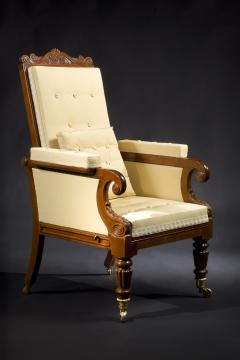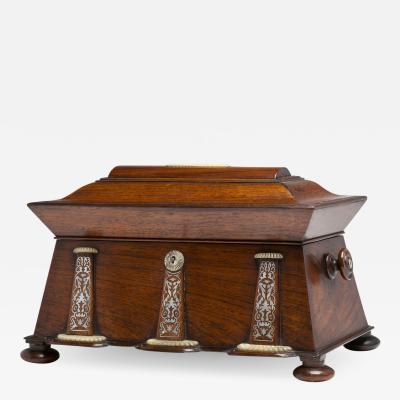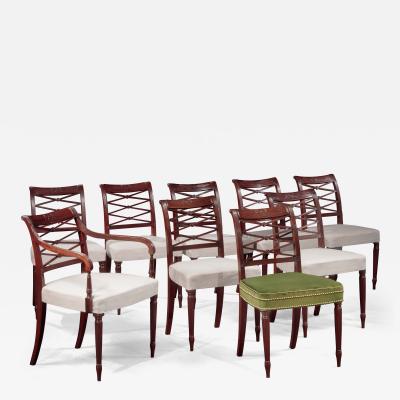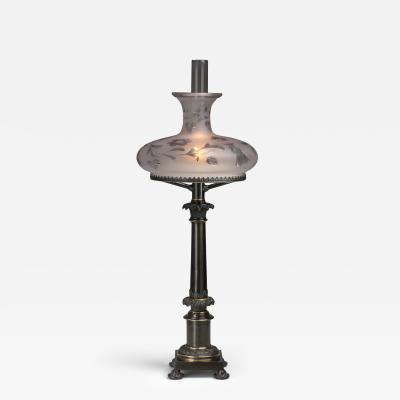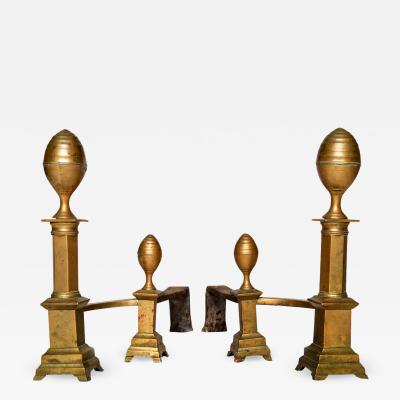Carved Mahogany Mechanical Arm Chair
-
Description
IMPORTANT CARVED MAHOGANY MECHANICAL ARM CHAIR
Possibly by Cook & Parkin (active1819-1833) and/ or John Hancock, upholsterer
Philadelphia, c. 1830
The lotus-carved arched crest rail above a beaded frame holding an upholstered back, hinged at the base, allowing the back to recline as the upholstered seat slides forward. The padded arm rests terminating in scrolls decorated with tiered, concentric bosses and supported by water-leaf carved scrolls, above turned and reeded front legs terminating in important gilt-bronze cup casters. The rear saber legs having brass caster wheels.
Woods: white pine and tulip poplar.
H: 46½” W: 27¼” D: 29”
Condition: Excellent: The front casters have been restored to their original matte and burnished lacquer appearance. The rear casters may be period replacements. Repairs to backing ledges and small restoration to bottom of proper right rear leg. The upholstery is modern using the materials and methods of the period. The chair has a shellac refinish.
Published: C. R. Berlin "'A Shadow of a Magnitude': The Furniture of Thomas Cook and Richard Parkin," American Furniture, ed. L. Beckerdite (Hanover, Chipstone Foundation, 2013).
This chair has been attributed to both Joseph B. Barry (1759/60-1838) and Charles White (1796-1876), two of Philadelphia’s most prominent cabinetmakers and legitimate arguments can be made for each, particularly for Barry. A group of four known arm chairs stamped by Joseph Barry & Co. made about 1829-1833 bear a resemblance to the present chair particularly in the arched chest rail and beaded framing of the back. Yet, the rare and distinctive water leaf carved scrolled arm supports that also appear as part of the pedestal of a group of center tables marked by Cook & Parkin suggests their hand.
Cook & Parkin, working at 56 Walnut Street were among the largest and most important cabinetmaking shops of the Classical period in Philadelphia, building one of the biggest export businesses in the city. Both Thomas Cook (1786-1868) and Richard Parkin (1787-1861), English born and trained, continued distinguished careers as cabinetmakers after the dissolution of their fourteen-year partnership; Parkin enjoying one of the longest careers of any Philadelphia cabinetmaker. The known work of these cabinetmakers consistently displays a deep knowledge of fashionable English and French pattern book designs and a keen sense of high style.
Cook & Parkin's shop was practically next door to that of Philadelphia upholsterer John Hancock, who with his brother William, in Boston, advertised mechanical easy chairs. Because of their physical proximity and the documented relationship between the craftsmen, we believe that this chair frame was probably ordered by Hancock from Cook & Parkin.
The design of the chair was undoubtedly derived from several English pattern book sources. Rudolph Ackermann’s Repository of Arts published four related designs to the present chair between 1810 and 1813 each of which clearly influenced the design of this chair. The Repository of Arts, published in London serially between 1809 and 1828, introducing all manner of fashionable apparel and furnishings, was very influential in the United States and nowhere more than in Philadelphia.
Another influential English pattern book published by Thomas King in 1829, Modern Style of Cabinet Work Exemplified shows several mechanical and easy chairs including “Chairs with inclining backs” (pl. 10 of the Supplementary Plates), that illustrate the exact construction of the back of the present chair. Plate 45 of “A Sideboard Table” shows a back splash that could easily have provided the inspiration for the arched, lotus-carved crest rail. The makers were unquestionably familiar with this publication.
The form of mechanical chair is rare in American furniture of this period and this is among the finest examples of the form that is known. A few Boston examples are known including one that was published by the Metropolitan Museum of Art in their exhibition catalog 19th-Century America (The Metropolitan Museum of Art, 1970), fig. 66. That chair has the remnant of a label of Boston upholsterer William Hancock (active 1820-1835), affixed to the bottom of the foot rest. The present chair is the only Philadelphia-made example of the form that is known.
Provenance: Private Collection
Anthony A. P. Stuempfig -
More Information
Origin: United States Period: 19th Century Materials: Carved Mahogany Condition: Excellent. New upholstery Creation Date: c.1830 Styles / Movements: Classical, Regency, William IV Incollect Reference #: 203802 -
Dimensions
W. 27.25 in; H. 46.5 in; D. 29 in; W. 69.22 cm; H. 118.11 cm; D. 73.66 cm;
Message from Seller:
Welcome to Carswell Rush Berlin Antiques, a premier New York City-based dealer specializing in American antique furniture and decorative accessories from the Classical period (1800-1840). For inquiries, please contact us at 646.645.0404 or email carswellberlin@msn.com.

















